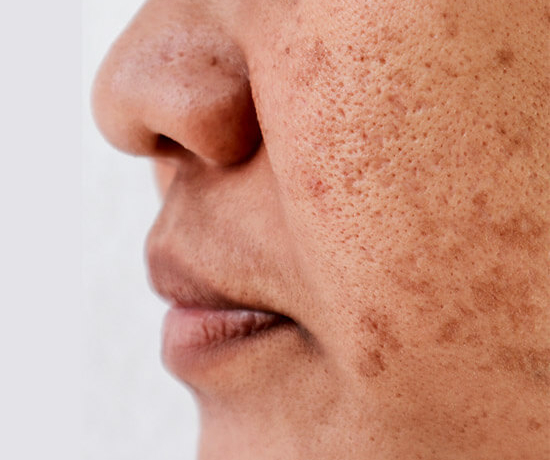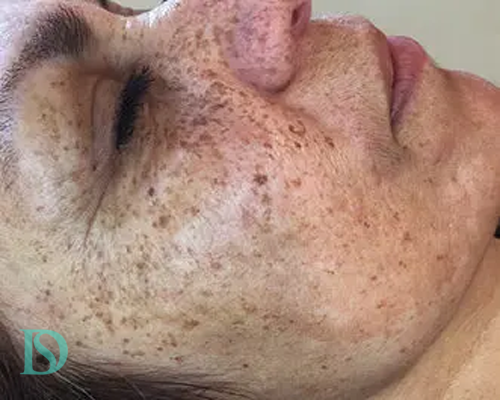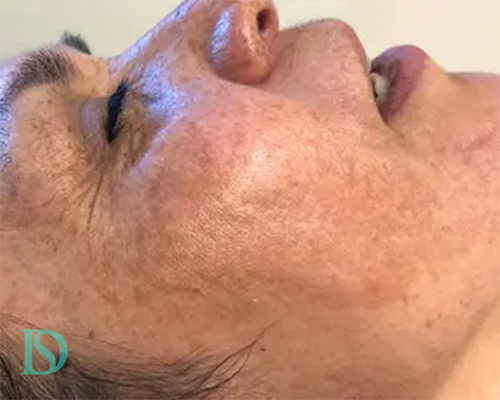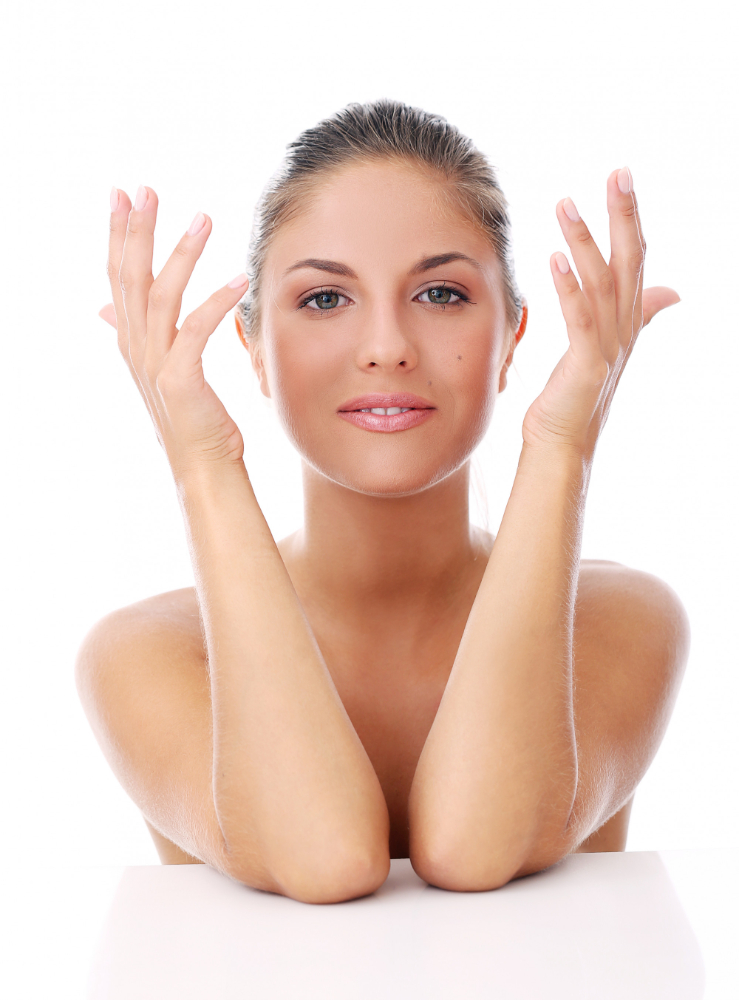Treatment at Derma Solution
IPL Pigmentation

How IPL Works for Pigmentation
IPL is a versatile and effective treatment for pigmentation, offering a non-invasive way to achieve clearer, more even-toned skin. With proper care and professional guidance, IPL can significantly improve the appearance of sunspots, age spots, and other types of hyperpigmentation
Light Absorption:
- During the IPL treatment, pulses of light are emitted onto the skin. These light waves are absorbed by the pigmented areas where melanin is concentrated.
- The light energy is converted into heat, which breaks down the melanin into smaller particles.
Natural Elimination:
- The fragmented melanin is gradually absorbed and eliminated by the body’s natural processes.
- Over time, the pigmented spots fade, resulting in a more even skin tone.
Collagen Stimulation:
- IPL also stimulates the production of collagen, a protein that contributes to skin firmness and elasticity. This leads to an overall improvement in skin texture and quality.
Results and Follow-Up
- Gradual Improvement: Pigmented spots may darken immediately after treatment, but they will gradually lighten over the following weeks as the skin heals.
- Multiple Sessions: Depending on the extent of the pigmentation, multiple IPL sessions (usually 3-6, spaced a few weeks apart) may be necessary to achieve optimal results.
- Long-Term Maintenance: To maintain the results, occasional maintenance sessions may be recommended, especially if new pigmentation develops due to sun exposure or aging.
Benefits of IPL for Pigmentation
- Effective for Various Pigmentation Issues: IPL can treat a wide range of pigmentation problems, including sunspots, age spots, melasma, and freckles.
- Non-Invasive: IPL is a non-surgical procedure, meaning there are no incisions or significant downtime.
- Quick Treatment: Sessions typically last 20-30 minutes, making it a convenient option for those with busy schedules.
- Minimal Discomfort: Most patients experience only mild discomfort during the treatment, often described as a snapping sensation on the skin.
Treatment Process
Consultation:
- Before starting IPL treatment, a consultation with a dermatologist or skincare professional is essential to assess your skin type, the type of pigmentation, and whether IPL is the right treatment for you.
Preparation:
- The skin is cleaned, and a cooling gel may be applied to the treatment area to enhance comfort and protect the skin.
- Eye protection is worn to shield your eyes from the intense light.
Procedure:
- The IPL device is passed over the treatment area, emitting light pulses. The number of pulses depends on the size of the area being treated and the severity of the pigmentation.
Post-Treatment Care:
- After the treatment, some redness or mild swelling may occur, which typically subsides within a few hours to a day.
- It’s crucial to avoid sun exposure and use broad-spectrum sunscreen to protect the treated areas and prevent further pigmentation issues.
Intense Pulsed Light (IPL) is a versatile treatment that can be used on various areas of the body to address pigmentation, improve skin tone, and treat other skin concerns. Here are the most common treatment areas for IPL:
1. Face
- Sunspots and Age Spots: Common on the face due to sun exposure, IPL can effectively lighten these spots.
- Freckles: IPL helps to reduce the appearance of freckles, leading to a more even skin tone.
- Melasma: While more challenging to treat, IPL can help reduce melasma in some cases.
- Redness and Rosacea: IPL is also effective in treating redness and the visible blood vessels associated with rosacea.
2. Neck
- Sun Damage: The neck is often exposed to the sun and can develop pigmentation issues similar to the face.
- Age Spots: IPL can help lighten age spots and even out skin tone on the neck.
3. Chest/Décolletage
- Sunspots and Freckles: This area is particularly prone to sun-induced pigmentation, and IPL can reduce these spots.
- Uneven Skin Tone: IPL can improve overall skin tone and texture in the chest area, making it look more youthful.
4. Hands
- Age Spots: Hands often show early signs of aging and sun damage. IPL can reduce the appearance of age spots and other pigmentation.
- Freckles: Like the face, hands can develop freckles, which IPL can effectively treat.
5. Arms and Shoulders
- Sunspots: Frequent sun exposure can lead to pigmentation on the arms and shoulders, which IPL can help fade.
- Freckles: IPL can be used to reduce freckles on the arms and shoulders, resulting in a more even skin tone.
6. Legs
- Pigmentation: Areas with uneven pigmentation or sunspots on the legs can be treated with IPL.
- Spider Veins: Although not directly related to pigmentation, IPL can also target small, visible blood vessels (spider veins) on the legs.
7. Back
- Sun Damage: The back is another area that can develop pigmentation due to sun exposure, especially in those who spend a lot of time outdoors.
- Freckles and Age Spots: IPL can reduce these pigmentation issues on the back.
8. Shoulders and Upper Back
- Freckles and Sunspots: Often exposed to the sun, the shoulders and upper back can develop pigmentation, which IPL can treat.
9. Abdomen
- Stretch Marks: While not a pigmentation issue, IPL can sometimes be used in conjunction with other treatments to help improve the appearance of stretch marks, which can have different pigmentation.
10. Bikini Area
- Post-Inflammatory Hyperpigmentation (PIH): IPL can help reduce dark spots caused by irritation or shaving in the bikini area.
Considerations for Different Areas
- Sensitivity: Some areas, such as the face or chest, may be more sensitive than others. The settings on the IPL device can be adjusted to accommodate these differences.
- Sun Exposure: Treated areas should be protected from the sun before and after IPL treatment to avoid complications like further pigmentation or burns.
- Multiple Sessions: Depending on the area and the severity of pigmentation, multiple IPL sessions may be needed to achieve the desired results.
IPL is highly adaptable and can be used across many body areas to address pigmentation and other skin issues, offering a non-invasive solution for achieving clearer, more even-toned skin.
Treatment Summary
Procedure Time:
15 – 60 mins
Back to Work:
Immediate
Anaesthetic:
Optional
Full Recovery:
1 – 21 days
Sensitivity Period:
Upto 72 hours
Duration of results:
Long term
Risks and Complications:
swelling, redness, peeling, itching
Book Now:
Procedure Time:
15 – 60 mins
Back to Work:
Immediate
Anaesthetic:
Optional
Full Recovery:
1 – 21 days
Sensitivity Period:
Upto 72 hours
Duration of results:
Long term
Risks and Complications:
swelling, redness, peeling, itching
Book Now:


Price GuaranteeOn All Treatment
Derma Solution offers a price guarantee on all of our treatment ranges. If you are able to find a treatment that we offer cheaper anywhere in Copenhagen we will match the price.
Laser Skin Rejuvenation
Treatment Prices
Laser Skin Rejuvenation
Frequently Asked Questions
The light from the laser is absorbed in several places in the skin
Melanin
The light is absorbed in the skin’s pigment melanin, after which the light is converted into heat. The heat destroys pigment spots and sun damage, so the colour is broken down into smaller colour grains.
It is the same principle that we know from tattoo removal. The damaged pigment will then penetrate the epidermis, after which it will peel off after 4-7 days. The skin will become uniform and look younger.
Haemoglobin
The laser light is also absorbed in the haemoglobin in the blood. Here, the laser light will again be converted into heat.
This heat removes superficial vascular ruptures, diffuse redness, heals red scars from e.g. acne, while reducing the acne bacteria on the skin.
The treatment is suitable for men and women of all ages.
You must not have dark skin and you must not have been in the sun for 4 weeks prior to the treatment.
You must be over 18 years of age to be treated with laser, unless there is a medical indication for it.
Prior consultation
Before you can have skin rejuvenation with a laser, you must have a statutory prior consultation with the clinic’s specially trained cosmetic nurse. Here you will be asked about the concerns you have and what you want with the treatment. In dialogue with the therapist, we will find the optimal solution for you.
The consultation is non-binding and free of charge.
Consideration period
There is no requirement for reflection time, and the consultation can therefore be held in connection with your first treatment.
Written patient instructions
We recommend that you read about the treatment in our patient guide, which you can download here on this page.
Precautions before treatment
It is important that your skin is as fair as possible before the treatment, and that you have not been in the sun for at least one month before the laser treatment. Sun exposure within a month can cause a superficial burn.
We also recommend coming without new self-tanner and make-up.
If you are sensitive to pain, you can take 1 gram of Panodil one hour before the treatment.
After the laser treatment, it is normal to feel warm and red in the skin.
Some will find that it resembles a sunburn. The redness and tingling sensation will subside after an hour.
The peeling will take place between 4-7 days after the treatment
The pigment spots will darken for a few days after the treatment. Some feel that it looks like they have coffee grounds on their face. This is the pigment that pulls up the top layer of skin and prepares for peeling. The peeling will take place between 4 -7 days after the treatment. It is only the pigment spot itself that peels off. You can easily go to work the day after the treatment.
Avoid the sun for at least 4 weeks and use a high sun protection factor
After a laser treatment, you must avoid the sun for a minimum of 4 weeks and use a high sun protection factor, as the pigment spots can return and, in the worst case, get worse. For this reason, we recommend laser treatments in the winter months.
In the first 2 years after the treatment, we recommend avoiding the sun, using a sun hat and SPF 50, as sun damage easily reoccurs. Alternatively, the treatment must be repeated in the autumn.
A single treatment may be enough
For some, a single treatment may be sufficient for the desired result. The majority can see a difference after just one treatment. However, it is very dependent on the actual starting point for the treatment.
We usually recommend 3 treatments 3 – 4 weeks apart to achieve the best result. We recommend that you combine this treatment with skin care products from Mesoestetics.
There is no downtime required following Global Eyecon treatment, and you can resume your daily activities more or less immediately. However, your under-eye area may be a little be red and sensitive following the procedure so factor that in when planning to have the treatment before an event.
There are also home care treatments to be applied after your session, to optimise and maintain the desired results. Your home care kit will comprise of products specifically formulated to prevent re-pigmentation, and protect against other signs of ageing.
Following your last session, it is essential to use sun protection that specifically prevents hyperpigmentation.



